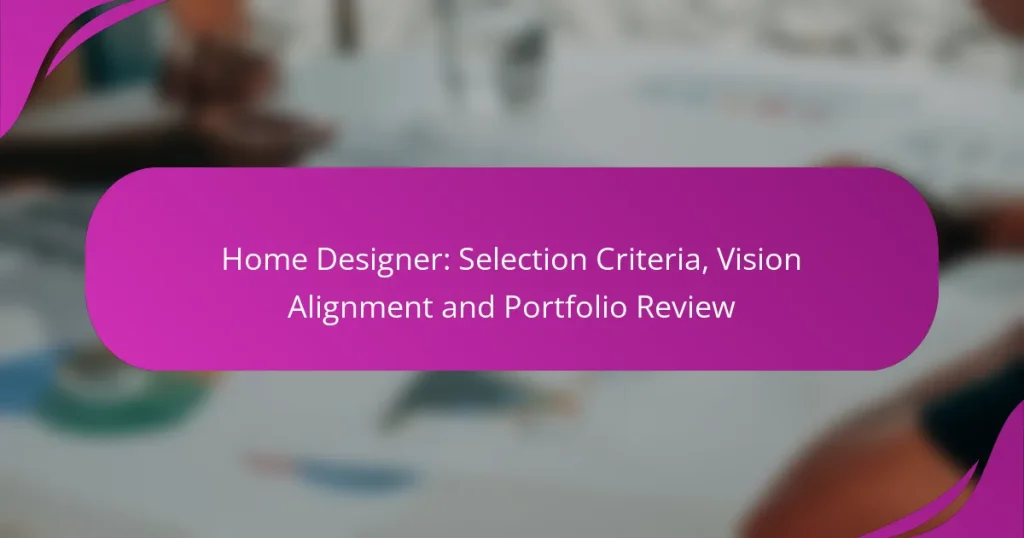Transform your living space with our personalized home design consultation, where we tailor our services to meet your unique style and needs. During this session, we will engage in a detailed discussion about your design preferences, budget considerations, and timelines. This collaborative approach ensures that your vision is seamlessly aligned with practical execution, paving the way for a smooth and enjoyable design journey.
Home Designer: Selection Criteria, Vision Alignment and Portfolio Review
Design Proposals: Evaluation Criteria, Cost Considerations and Aesthetic Fit
Initial Consultation: Expectations, Preparation and Key Questions
Style Preferences: Communication Techniques, Visual Aids and Designer Collaboration
Client Feedback: Impact, Integration and Design Improvement
Budget: Influence on Design Choices, Consultation Scope and Material Selection
What are the benefits of personalized home design consultation in Canada?
How does a personalized home design consultation work?
What should I expect during a home design consultation?
During a home design consultation, you can expect an in-depth discussion about your design preferences, budget considerations, and timelines. This meeting is crucial for aligning your vision with practical execution, ensuring a smooth design process.
Detailed design discussion
The detailed design discussion focuses on your specific needs and preferences. You will share your ideas, inspirations, and any existing constraints, such as space limitations or structural elements that must be considered. This dialogue helps the designer understand your style and functional requirements.
Be prepared to discuss various design elements, including layout, color schemes, and furniture styles. Bringing visual aids, such as photos or mood boards, can facilitate clearer communication and help the designer capture your vision accurately.
Budget and timeline overview
Budget and timeline discussions are essential to set realistic expectations. Your designer will help you outline a budget that covers all aspects of the project, including materials, labor, and any unforeseen costs. It’s advisable to have a range in mind, as home design projects can vary significantly in cost.
Establishing a timeline is equally important. Your designer will provide an estimated schedule for each phase of the project, from initial design to final installation. Discussing potential delays and how they might impact your overall timeline can help you plan accordingly.
Material and style recommendations
Material and style recommendations will be tailored to your preferences and budget. Your designer will suggest suitable materials that align with your aesthetic while considering durability and maintenance. For example, if you prefer a modern look, they might recommend sleek finishes and contemporary fixtures.
It’s beneficial to explore various styles and materials during the consultation. Ask about the pros and cons of different options, such as hardwood versus laminate flooring or quartz versus granite countertops. This knowledge will empower you to make informed decisions that enhance both the beauty and functionality of your home.
How to choose the right home design consultant in Canada?
Choosing the right home design consultant in Canada involves evaluating their qualifications, experience, and compatibility with your vision. Focus on their expertise in local design trends and regulations to ensure a successful collaboration.
Check credentials and experience
Start by verifying the consultant’s credentials, such as degrees in architecture or interior design and any relevant certifications. Look for experience in residential projects similar to yours, as this indicates their capability to handle your specific needs.
In Canada, many consultants may also be members of professional associations like the Canadian Society of Interior Designers (CSID) or the Royal Architectural Institute of Canada (RAIC). Membership in these organizations often signifies adherence to industry standards and ongoing professional development.
Review portfolio and client testimonials
Examine the consultant’s portfolio to assess their design style and versatility. A strong portfolio should showcase a range of completed projects that align with your aesthetic preferences and functional requirements.
Client testimonials can provide insight into the consultant’s work ethic and reliability. Look for reviews that highlight their ability to meet deadlines, stay within budget, and communicate effectively throughout the design process.
Assess communication style
Effective communication is crucial for a successful home design project. During initial consultations, pay attention to how the consultant listens to your ideas and responds to your questions. A good consultant should be open to feedback and willing to collaborate.
Consider scheduling a follow-up meeting to gauge their responsiveness and willingness to adapt their designs based on your input. This will help ensure a smooth working relationship throughout the project.
What are the costs associated with personalized home design consultations?
The costs for personalized home design consultations can vary significantly based on the service structure, location, and the designer’s experience. Generally, clients can expect to pay either hourly rates or flat fees for comprehensive services, depending on their specific needs and the scope of the project.
Hourly rates for consultations
Hourly rates for personalized home design consultations typically range from $50 to $300 per hour, depending on the designer’s expertise and the project’s complexity. Newer designers may charge on the lower end, while established professionals with a strong portfolio may command higher fees.
When considering hourly rates, it’s essential to clarify what is included in the consultation. Some designers may offer a free initial consultation, while others might charge for every hour spent, including planning and follow-up communications. Always ask for a detailed breakdown of services to avoid unexpected costs.
Flat fees for comprehensive services
Flat fees for comprehensive home design services can range from a few hundred to several thousand dollars, depending on the project’s size and scope. This pricing model is often preferred for larger projects, as it provides clients with a clear understanding of total costs upfront.
When opting for flat fees, ensure that the contract outlines all services included, such as design concepts, material selections, and project management. This helps prevent misunderstandings and ensures that all aspects of the design process are covered without hidden charges.






